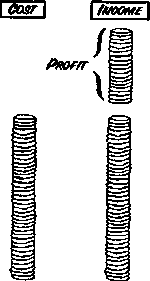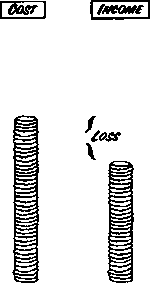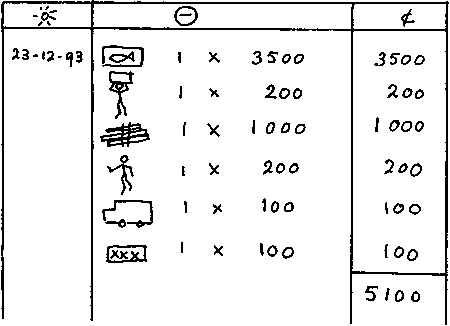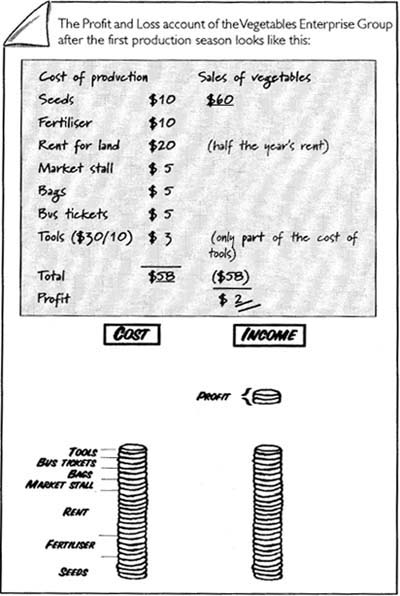Method:
Show some example calculations and try and work out the profit that a member of the group makes from one of their enterprises. Making a profit means that the value of what you produce and sell is greater than the cost of producing it. These diagrams may help - they come from “The group enterprise resource book” published by FAO.



Example 1:
(Taken from Simple Book-keeping and Business Management Skills published by FAO.) Symbols and pictures are used to overcome literacy problems.
Mary buys and smokes fish, which she then sells in the village. On one day she:
Pays a toll at the market of ¢100.
She sells the smoked fish for ¢6,000.

Mary’s expenses:

Mary’s income:

Mary’s profit:

Discussion topics:
If Mary had decided at the end of the day to reduce the price and sell her fish for only ¢5,000, would she have made a profit or a loss? (¢5,000 - ¢5,100 = ¢-100 loss)
If Mary had stored one basket of smoked fish until the lean season and sold it when the price was ¢7,000, what would her profit have been? (¢7,000 - ¢5,100 = ¢1,900 profit)
Example 2:
Taken from “The group enterprise resource book” (FAO).
This example illustrates how you should only include a share of the cost of items that will be used over a number of production cycles, e.g., tools, which will last several years. In the example you can see that the group spent $30 on tools and they think the tools will last for 10 production cycles. So the cost of tools for one production cycle is only $3.

Example 3:
When you are thinking of starting a new enterprise, you have to make a forward budget.
This is a budget to estimate the profitability of growing tomatoes.
Some technical words are used, e.g., variable costs and fixed costs - they are useful if people understand them. Variable costs change when you increase or decrease production, fixed costs tend to stay the same whether you grow more or less.
|
Income |
|
|
|
| |
50kg tomatoes sold at $2 per kg. |
$100 |
|
|
Total income |
|
$100 |
|
| |
Variable costs |
|
|
|
Seeds |
$ 10 |
|
|
|
Fertiliser |
$ 25 |
|
|
|
Chemicals |
$ 15 |
|
|
|
Bags |
$ 10 |
|
|
|
Fixed costs |
|
|
|
| |
Market licence |
$ 5 |
|
|
Transport |
$ 11 |
|
|
|
A share of the cost of tools (depreciation) |
$ 4 |
|
|
|
Total costs |
|
$ 80 |
|
|
Profit |
|
$ 20 |
|
Discussion points:
If you could only sell the tomatoes for $1 per kg. or could only sell half of them, what would happen to the profit? (The enterprise would, in fact, make a loss of $30.)
How much risk is there that you might not be able to sell your produce?
If you started growing tomatoes would it affect or reduce your income from other enterprises?